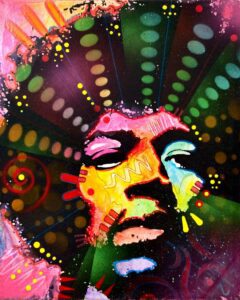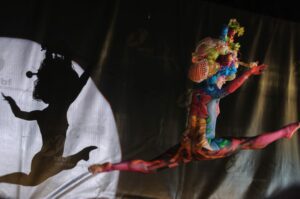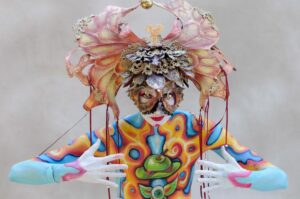In the ever-evolving world of art, “happenings” are a vibrant fusion of performance, art, and life itself.
They blur the lines between artist and audience, creating an immersive experience that’s as unpredictable as it is captivating.
We’ll jump into the history, impact, and current landscape of happenings, exploring why they remain a compelling form of artistic expression.
Stay with us as we uncover the dynamic ways happenings continue to shape the art world today.
History Of Happenings In Art
Happenings began to emerge in the late 1950s and early 1960s, initially as a form of protest against the conventional art scene.
Pioneered by artists like Allan Kaprow and Claes Oldenburg, happenings were designed to be spontaneous, interactive events that broke down the barrier between performer and audience.
Kaprow coined the term after his piece 18 Happenings in 6 Parts, which challenged traditional art forms by integrating life and art into an inseparable whole.
The core principles of happenings were rooted in the Dadaist philosophy, which celebrated the unpredictable and the whimsical.
Happenings often took place in unconventional spaces – warehouses, streets, or even a barn.
This movement was less about the final product and more about the experience.
Key elements typically included:
- Unscripted performances – Audience participation – A fluid, non-linear narrative.
During the 1960s, happenings started to influence mainstream culture and intersected with the rise of the Fluxus movement.
Artists like Yoko Ono and George Maciunas propelled the concept even further by emphasizing the art in everyday experiences and the idea that anyone could partake in the creation of art.
They utilized film and video to document these ephemeral events, pushing the boundaries of what art could be and how it could be consumed.
The infusion of happenings into the broader art world led to the evolution of performance art as we know it today.
Marina Abramović and Ulay, for example, continued to explore the body and its limits within performance, but with a more structured approach than the original happenings.
While the raw spontaneity of the original happenings isn’t as prevalent, the legacy of happenings paved the way for interactive and interdisciplinary art forms that continue to challenge and redefine the relationship between art, artist, and audience.
The Impact Of Happenings On The Art World
Happenings have had a significant effect on the trajectory of contemporary art.
By eliminating the traditional boundary between the artist and the audience, these events redefined the concept of art as an immersive, participatory experience.
The influence of happenings rippled through various art forms, introducing new dimensions to the way art is created and consumed.
The Interactive Nature of Happenings
- Encouraged breaking down the ‘fourth wall’ in theater and other performative arts,
- Spurred on the development of installation art, where the environment becomes a part of the art experience,
- Paved the way for art to become an active dialogue between the creation and the observer.
Pioneers of happenings like Allan Kaprow insisted that life itself could be art, an idea that was radical for the time.
This
We see the legacy of happenings in the widespread public art movements and community art projects that are popular today.
The happenings of the 1960s also made significant contributions to the evolution of art mediums.
For instance, the use of mixed media became prevalent, as happenings often called for a fusion of elements from various art forms.
This laid the groundwork for multimedia installations and experimental film where blending sight, sound, and environment is integral to the artistic impact.
The Legacy in Modern Art Practice
- Fostered the growth of performance art as a major contemporary art form,
- Influenced the rise of conceptual art, where the idea takes precedence over traditional aesthetic and material concerns,
- Reflected in the interactive digital media works that invite viewers to engage directly with the artwork.
As filmmaking specialists, we appreciate the way happenings have transformed the relationship between various art forms, including film.
Experimental filmmakers have borrowed the spontaneous and participatory ethos of happenings, creating works that are open-ended and interactive.
Today’s immersive cinema, virtual reality experiences, and interactive video installations owe much to the groundbreaking shifts introduced by happenings.
Artists today continue to build upon the principles of happenings, adapting their spirit to the changing cultural and technological landscape.
The result is an ever-evolving art world that remains as dynamic and unpredictable as the happenings themselves.
Characteristics Of Happenings
Happenings blur the line between life and art, reflecting a desire to engage audiences beyond passive observation.
These events hinge on the concept of spontaneity and often include unpredictably evolving scenarios that participants co-create with the artist.
- Environments are transformed into interactive stages where anything can happen. – Ordinary objects are repurposed into art, challenging our perceptions and encouraging us to see the beauty in the mundane.
The participants play a vital role, as they’re not just observers but active contributors to the creative process.
This immersion breaks traditional expectations of behavior in art spaces, allowing for a fluid exchange of ideas and expressions.
- Experimentation is encouraged, embracing chance over choreography.
- The line between performer and spectator is intentionally blurred.
In our examination of the art world, we recognize Happenings as multisensory experiences that often involve a combination of visual art, performance, and sound.

Allan Kaprow’s influential pieces emphasize this, where painting, sculpture, and architecture converge with music and movement to create a symphony of sensory stimuli.
- Mixed media is a common thread, pulling from various artistic disciplines.
- The use of space is innovative, with non-traditional venues becoming canvases for expression.
We’ve seen Happenings influence not only art but also the realm of filmmaking.
They’ve molded the way we think about cinema, pushing us toward more experimental forms of storytelling that resonate with audiences on multiple levels.
- They’ve paved the way for avant-garde film techniques.
- Interactive and immersive cinema experiences draw heavily from the concepts of Happenings.
Notable Happenings Throughout Art History
As enthusiasts delving into art movements, we’ve witnessed how Happenings have transformed artistic expression in multifaceted ways.
These events challenge our understanding of art, merging creativity with unpredictable live elements.
The 1950s And 1960s – The Birth Of Happenings
The 1950s ushered in Happenings, with their epicenter in the United States.
Artists like Allan Kaprow, who coined the term, pioneered this new form:
- Allan Kaprow’s 18 Happenings in 6 Parts – sparked the conceptualization of Happenings,
- Claes Oldenburg’s The Store – transformed a commonplace environment into an interactive art experience.
Evolution And Global Influence
By the 1960s, Happenings began to take on international flavors:
- Japan’s Hi Red Center staged elaborate street performances,
- In Europe, Happenings became synonymous with political activism.
The cultural ferment of the era fueled these events, as artists strove to tear down the barriers between art, life, and the audience.
Synthesis With Experimental Cinema
In parallel to the visual arts, the ethos of Happenings profoundly influenced experimental cinema:
- Filmmakers like Maya Deren experimented with form and narrative structure,
- Jonas Mekas captured the spontaneity of life through his avant-garde films.
This cross-pollination between fine arts and filmmaking spurred new, immersive cinema experiences.
The Ongoing Legacy
The influence of Happenings continues to pulse through the veins of contemporary art:
- Flash mobs draw from the participatory nature of Happenings,
- Improvised performance art pieces recall the unscripted, moment-to-moment ethos.
From the streets to the galleries, Happenings reinforce the
Current Trends And Evolution Of Happenings
In the arena of contemporary art, happenings have continued to unfold in fascinating ways, adapting to cultural shifts and technological advancements.
Today, happenings harness digital tools to create immersive experiences that were once unimaginable.
With the integration of virtual reality and augmented reality, artists are able to transcend physical limits, inviting participants to engage with artwork that responds to their presence and actions.

social media’s meteoric rise has also contributed to the evolution of happenings.
By enabling immediate sharing and global reach, platforms like Instagram and Twitter Help interactive and participatory experiences in real-time, extending the life of a happening well beyond its initial performance.
These digital happenings not only democratize art by making it more accessible but also challenge traditional boundaries between creator, artwork, and audience.
- Pioneers of modern happenings are using artificial intelligence to generate never-before-seen forms of interaction.
- Live-streaming technologies are enabling happenings to reach audiences across continents, dissolving geographic constraints and fostering global participation.
- Happenings are increasingly site-specific, creating unique narratives and experiences tailored to their environment, whether it’s a bustling city square or an abandoned industrial site.
As these currents ebb and flow, it’s clear happenings aren’t merely surviving – they’re thriving, adapting, and proliferating in the art world and beyond.
Collaboration with other artistic disciplines, notably filmmaking, has imbued happenings with a cinematic quality.

Films like Sleep No More have blurred the lines even further between audience and performer, drawing spectators into the frame as living components of the piece.
Understanding these ongoing transformations ensures that our grasp of happenings remains as dynamic as the art form itself.
As we jump deeper into the synergy between happenings and cinematic narrative, it becomes evident that the potential for future innovation is boundless.
With every step forward, happenings continue to redefine the very essence of art and audience interaction.
What Is Happenings In Art – Wrap Up
We’ve seen how happenings are reshaping the art landscape, pushing boundaries and inviting us into a world where art and life seamlessly merge.
Their influence on various creative fields is undeniable, fostering a spirit of collaboration that continues to challenge and redefine our perceptions of art.
As technology evolves, so too does the potential for happenings to captivate and engage audiences in ways we’ve yet to imagine.
With social media as a catalyst, the reach and impact of these events extend far beyond the moment, ensuring that the conversation—and the art—lives on.
Let’s stay attuned to the pulse of happenings, for they promise an ever-expanding horizon of artistic expression and cultural dialogue.
Frequently Asked Questions
What Are Happenings In The Context Of Art?
Happenings are performance-based art events that combine elements like visual art, improvisation, and audience interaction to create a dynamic and often unpredictable artistic experience.
How Do Happenings Engage Audiences?
Audiences are engaged in happenings by participating and collaborating in the creation of the art, often contributing to the unpredictability and unique outcome of each event.
What Elements Are Commonly Found In Happenings?
Common elements in happenings include visual art, performance, sound, improvisation, and audience interaction, often within a planned framework allowing for spontaneous expression.
How Have Happenings Influenced Filmmaking?
Happenings have influenced filmmaking by inspiring experimental storytelling techniques, merging reality with performance, and incorporating unscripted, real-time audience engagement.
How Has Technology Affected The Evolution Of Happenings?
Technology has allowed happenings to incorporate virtual reality (VR) and augmented reality (AR), expanding their reach beyond physical spaces and enhancing audience immersion.
What Role Does Social Media Play In Relation To Happenings?
Social media extends the life of happenings by allowing them to be shared, discussed, and re-experienced, challenging traditional boundaries and enabling global participation.
Are Happenings Still Relevant Today?
Yes, happenings continue to thrive and evolve, remaining relevant by adapting to cultural and technological changes and maintaining their dynamic nature in the art world.





